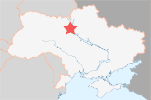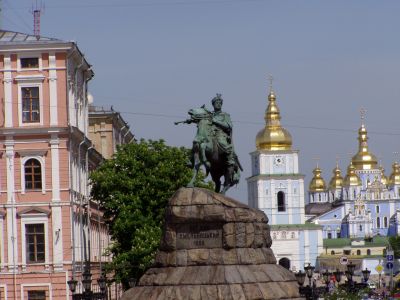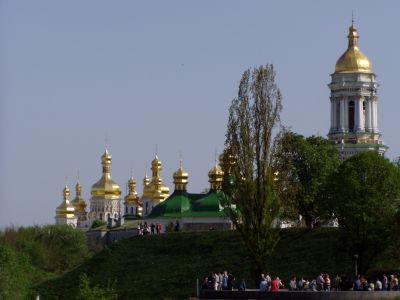Name

| ||
| Kyiv (Kiev) |
There are many different spellings of the capital of the Ukraine. Київ (Kyiv) is the Ukrainian name and is used by Ukrainians. More common in the English speaking world is "Kiev", which derives from the old name and is closer to the Russian place name Киев. Other spellings include "Kijev", "Kiew" and "Kijóv".
Location
Kiev lies in the northern centre of the country at the river Dnepro. In Ukrainian, the river is called Дніпро (Dnipro), but the spellings "Dnjepr" and "Dnieper" are quite often in use as well. The river has its source in Russia near Smolyensk, flows through the northern neighbour →Belarus and flows into the Black Sea west of the Crimea peninsula near Cherson. The Dnipro divides not just the country but also Kyiv into western and eastern part. The historic part of the town stretches around some hills at the right (west) bank of the city. A few kilometers before and behind Kiev, the Dnipro is dammed up and some dozen kilometers wide.

| ||
| A view of Dnipro (Dnjepr) and the east, where the endless plain starts, from the hills at the western bank |
In Kiev, the river is "only" around 1 km wide. However, due to the islands in the middle of the river, it's impossible to understand the real size of the river. Around 90 km upstream, Chernobyl marks the place of the world's worst nuclear accident. around 350 km downstream, →Dnepropetrovsk, the second-biggest town of the Ukraine, straddles the river.
Population
In every aspect, Kyiv is the capital of the Ukraine. Today, the city has around 3 million inhabitants.
History
Kiev has a very long history. Founded in the 5th century, the town became the capital of the Kievan Rus', founded by Vikings. At that time, Kiev was called "mother of all cities". During the early middle ages, Kiev was the most important town between Scandinavia and Byzantium not only because it was located at one of the waterways connecting both historic areas. In the year 988, the christianisation of the Kievan Rus' was initiated in Byzantium and made Kyiv the spiritual capital of the area. Since 1169, the Kievan Rus started to slowly fade away and passed over supremacy to Moscow. In 1240, Mongols invaded the Rus and flattened Kiev completely. The city didn't recover and never gained the same importance again.
Getting there / transportation

| ||
| Independence square in the centre of Kyiv |
Of course, Kiev is also the most important transportation hub in the contry - with the Ukraine's largest international airport and the largest number of national and international train connections . There are numerous train connections to all countries around the Ukraine - most of them, however, to Russia. National connections include trains to →Odesa (600 km, 10 hrs, € 7 in a compartment), →Dnepropetrovsk (520 km, 6 to 12 hrs, € 6 in a compartment) and to →L'viv (Lvov) (540 km, 11 hrs, € 7). A ticket for the international train to Berlin for example costs around € 100 - single, incl. the sleeper fee. For more information on getting there, see →Travel information Ukraine.
Майдан Незалежності (Kiev Passashirsky - Kiev Terminal)
Kiev Passashirskii, abbr. Kyiv Pass (passenger terminal) is the main train station of the capital and the starting point for all train travellers. The station itself consists of the old big east wing and a vibrant square in front of it. The western part is very modern. In front of the western part, a beautiful orthodox church welcomes the visitor. The centre of town as well as the subway station and the taxi stop are on the eastern part. Ticket counters can be bought in both parts. There are many waiting rooms and kiosks inside the section between the wings and above the platforms. There's a fast food restaurant serving Ukrainian dishes in the western wing. Try to avoid it, it's lousy. West of the station, large living quarters stretches to the west. The centre of town is three subway stops away, which is too far away to walk.
Майдан Незалежності (Maidan Nesaleshnosti - Independence Square)
The maidan Nezalezhnosti, translated "Independence square", marks the centre of town and is surrounded by some older buildings, which are unfortunately "decorated" by large advertisment billboards. Most of the buildings seem to be from the Stalin era (see picture ). Nevertheless the square is a pleasing and harmonic ensemble. The square features some fountains, steps and a large column, which is a popular meeting place. It's a nice place for having a rest and strolling around, and so it's a vibrant place. Next to the square is a subway station with the same name.
вул. Хрещатик (Khreschatyk)
From the north to the south, the Khreschatyk rd. crosses Independece Square. This is Kiev's most expensive boulevard, where banks, office buildings, boutiques and chic restaurants line up. Additionally, a big post office and other important facilities can be found as well. The boulevard leads straight to the green hills along the Dnipro river in the north.
Парк Володимирська Гірка (Volodymyrska Hirka-Park)
The western part of Kiev's green lungs is called Volodymyrska Hirka-Park and offers a splendid view over the town. Walking the mostly forested hills means to escape the noise of the town. Inside the park atop a hill overlooking the Dnipro, you can find the next sight:
Пам???ятник Князя Володимира (Pam???yatnik Knyaza Volodimira - Monument of St. Volodymyr)
Prince Volodymyr the Great (the old name would be Vladimir) decided in 988 that Christianity would be the country's religion, which had a large impact on the entire eastern Slavic world. Furthermore he successfully fought back nomad tribes inveding the Kievan Rus' from time to time. Legend has it that Kievans were brought to the Dnipro and (partially by force) baptised. To get there, they needed to follow the trail which later became the Khreschatyk (see above). Khreschatyk simply means 'baptism'. Next to the monument is a small cable car leading to one of Kiev's top sights:
Свято???Михайлівський Золотоверхий Монастир (Svyato Mihailivskii Zolotoverchii Monastir - St. Micheals Monastery)

| ||
| St. Michael Monastery |
The St. Michael monastery (also spelled St. Michail's) is impossible to miss - it's mainly painted azure and has a few golden domes on top of it, with some white elements completing the marvellous ensemble. I guess the monastery is not so impressive when it rains, but it's great beneath blue sky. Parts of the monastery were built in the 18th century. Unfortunately, the entire monastery fell victim to the war against religion in the year 1936. It could not be rebuilt before 1997/8. The main building as well as the belfry are highly interesting. It's not allowed to take pictures inside the church, which is a pity. The monastery houses a historic museum.

| ||
| St. Michael monastery in the centre: a beautiful combination of azure, gold and white.. |
пл. Михайлівська (pl. Mihailivska - Michael Square)
South of the monastery, the large (Michael aka Michail Square stretches southward. Buildings facing Michail square include the Ukrainian Historic Museums and many other old and modern buildings. There's a large horseman statue, a Cossack hero monument to be exactly, in the middle of the square, dedicated to Bohdan Khmel'nyts'kyi. He collaborated with the Russians to fight back the Poles, but this actually sealed the end of the Ukrainian independence

| ||
| The Michailivska square in the heart of Kiev |
Софійський Собор (Sofiiskii Sobor - St. Sophie Church)
Very impressive and definitely a highlight is the contrast between the blue and gold St. Michail monastery north of the square and the green and white St. Sophia church (often called St. Sophia's cathedral) south of the square. This church was built in the year 1037 and is considered to be Kiev's oldest church.

| ||
| St. Sophia's church |
Since the church was the main seat of the church in the Kievan Rus', it was honoured by receiving the same name as the very important →Hagia Sophia (St. Sophia) in Istanbul, at that time known as Byzantum. However, most of the present-day St. Sophia church had been built in the 17th century and was designed in the so-called Ukrainian baroque style. There are many original (=11th century) frescoes and mosaics on display inside the church. The exterior as well as the interior are gorgeous and definitely worth a visit. Entrance fee is 10 Grivna, a photo permission costs an extra 20 Grivna (really a bad habit in the Ukraine).
Андріївський Узвіз (Andriivskii Uzviz)
When you come out of St. Sophia church and walk left past the square, you will soon enter Andrew-Alley, called Andriyivskii Uzviz in Ukrainian. This is a not very big, steep and partially cobbled road. Here, countless people hawk different things like art and souvenirs but also second-hand things. Most of the paintings for sale are rather kitsch, but some are interesting. There are also some commercial galleries lining up. Looking for beautiful chessboards? This is the place to go... Since there aren't any souvenir shops around the Ukraine, it's not a bad idea to go to Andrew Alley.

| ||
| Andrej- (resp. Andrew) alley: a steep road, where lots of handicraft and other products are sold |
Андріївська Церква (Andriivska Tserkva)
Halfway on Andrew alley, baroque St. Andrew church is towering the street bazaar. It's unusual dome colour (some sort of turquoise) makes it easy to spot. This church was built in 1749 and dedicated to Catherine the Great. It had been reconstructed recently. The Italian architect, Bartolomo Francesco Rastrelli, is also famous for the Eremitage in St. Petersburg. The iconostas inside the church is quite impressive as well. Admission fee is 10 grivna, photo permission (of course!) costs an extra 20 grivna.

| ||
| The baroque Andrej church, built in 1749 and dedicated to Catherine the Great |
Парк Вічної Слави (Park vichnoi Slavi)
When you walk along the Dnipro direction south-east, you will get to Park Vitschnoyi Slavi (Park of Highest Fame). There's an obelisk-like cenotaph dedicated to the victims of World War II in the centre of the park atop a hill. Especially on 9 May, the day of the victory over Nazi Germany, many war veterans and their families gather at the monument for laying of wreaths.

| ||
| A highly decorated war veteran at 9 May (liberation day), which is still a bank holiday in the Ukraine |
Києво-Печерська Лавра (Kievo-Pecherska Lavra)
Next to the park, the historic Kiyevo-Pecherska Lavra (caves monastery of Kiev) stretches along the Dnipro in the middle of Pechersk district - one of the oldest parts of Kyiv. The whole area of the monastery is 28 hectare big, quite hilly and numerous caves run through the underground - hence the name. Since 1051, monks lived inside the caves, which also marked the foundation of the monastery.

| ||
| The marvellous, recently reconstructed and very big Pecherska monastery |
Today, the Caves Monastery is a large, loose collection of several churches and other monastery related facilities. During the Soviet Union, the monastery was misused as a so-called culture-historic building ensemble respectively museum. In 1988, monks started to use the area as a monastery again. In the centre of the monastery, beautiful Uspenski cathedral (see picture) attracts the visitors attention. For along time it was said that the German army had destroyed the church, but newest reseach showed that the Red Army blasted the building. It was rebuilt only a few years ago.
There are some museums around the cathedral, among them a book- and printing museum and a theatre, music and cinema museum. For some reason, the monastery has got its own extensive website, but it's only in Russian and Ukrainian: http://www.lavra.kiev.ua/.

| ||
| Splendid, perfectly restaurated churches in the monastery |
Another highlight of the monastery are the Печери (Pecheri) (=caves) themselves. These dark labyrinths are devided into the "close caves" and the "far caves". The close caves are 1.5 km long, the far caves only 300 m. There are many niches carved into the rock. Glass coffins containing mummified monks wrapped in white linen are placed in the niches. Many pilgrims come here to pray fervently - a very spiritual place. For visitors it's sometimes possible to see the caves and the mummies. However, one will soon notice that strangers are somehow out of place.
Родина Мать (Rodina Mat' - Mother Nation)

| ||
| Rodina Mat' - Mother Ukraine |
Next to the monastery is the National Museum about the History of the Great Patriotic War (against Nazi-Germany). The museum area is quite big. Thanks to the large monument "Rodina Mat'", lit. 'Mother Home country', the museum can't be missed. The monument itself is more than 100 m high and reminds the visitor of the devastating but glorious fight against Hitler. The good woman has at least two sisters - one is Mother Georgia in →Tbilisi, the other one Mother Armenia in →Yerevan. Yes, mothers were beloved people in the Soviet Union!
Arriving late at night in Kiev (which is the case when you take the Berlin-Kiev express train) is not a very good idea, since there are no hotels close to the main train station. And there's no more public transport. There is a hotel inside the station, but it seems to be rather expensive. Furthermore there's no tourist information or something similar. For us, it ended up like this: A taxi driver approached and asked whether we were looking for accommodation. And how much we would pay for a night. "For the two of us 200 Grivna at most", I answered. I could have left out the "at most", because the price for the accommodation he offered was of course exactly 200 Grivna (€ 35). Eventually he brought us to a nice and big appartment not far from the train station. Quite expensive, but according to our (Japanese) guidebook, most hotels in Kiev charge more than 300 Grivna for a double room.
The place was about 10 minutes on foot south of the train station and turned out to be a
very nice and fully equipped appartment with two rooms, kitchen, bathroom and so on.
Conviniently located and not far from the bus station. However, no places of interest and good
restaurants nearby. Again - at that time we paid 200 UAH for one night for the two of use.
It was possible to ask them directly (though at that time they didn't speak any English):
Address: Kavkazkaya 12 kv. 5/29
Tel.:(044)-451-59-66
(Natalja Fjodorowna)
- kmv.gov.ua/ Official website of Kiev, incl. an English version.
- www.uazone.net/Kiev.html Plain but useful website about the capital - in English.
- www.kiev-ukraine-information.com Private website about Kiev - and the pictures on it are well worth digging into it. English.
Do you have or do you know a good website about Kiev? Don't hesitate, let me know! After checking it, I would love to add it to the link list. You can submit a link by using the →contact form. Note that commercial websites will be treated differently.
©2024 Europe-East.com

 Albania
Albania Ukraine
Ukraine